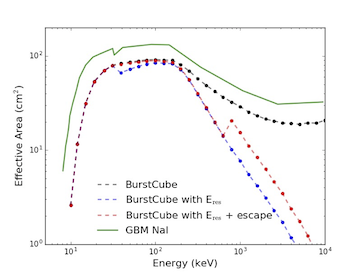BurstCube Image: Science


Simulation of combining BurstCube and LIGO locationizations of a gravitational wave
and burst event (such as binary black hole merger such as GW151226)

The integrated relative exposure of BurstCube over a single orbit
shown in celestial coordinates (Mollweide projection).

BurstCube localizes short gamma-ray burst sources (sGRB) to an accuracy of ∼7°
when viewed by three or more detectors. The localization errors (in degrees radius) are shown
here across the entire BurstCube field of view (in Az/El coordinates). There is some
attenuation of signals seen through the spacecraft bus, and complete occulation of sources
by the Earth.

Detector simulation of the effective area of the BurstCube detectors as a function
of energy (shown at 15 degree incidence), including comparison to the Gamma ray
Burst Monitor (GBM) instrument on the Fermi satellite. The effective area is ∼70%
of the larger GBM NaI detectors at 100 keV.

Total sky coverage in search for Gamma Ray Burst sources, with Swift Burst Alert Telescope
(BAT), Fermi Gamma ray Burst Monitor (GBM), and combination with BurstCube.